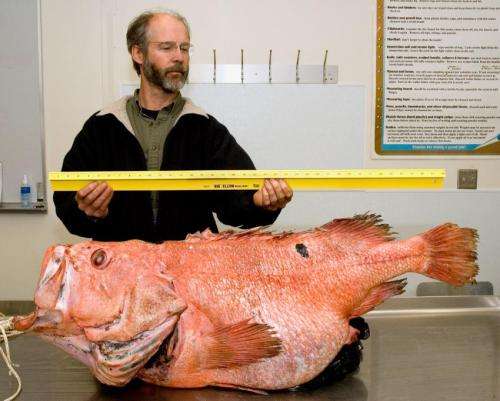BOFFFFs (big, old, fat, fertile, female fish) sustain fisheries

Recreational fishermen prize large trophy fish. Commercial fishing gear targets big fish. After all, larger fish feed the egos of humans as well as their bellies.
A new compilation of research from around the world now shows that big, old, fat, fertile, female fish – known as BOFFFFs to scientists – are essential for ensuring that fishery stocks remain sustainable.
"Information on many different kinds of freshwater and marine fish tell the same story," says lead author Dr. Mark Hixon of the University of Hawai'i at Mānoa. "The loss of big fish decreases the productivity and stability of fishery stocks." This loss, known as "size and age truncation," typically occurs in all fisheries.
Methods of saving big fish include slot limits, where regulations allow only the capture of medium-sized fish, as well as marine reserves, where some fish are allowed to spawn over their entire life spans.
There are multiple ways BOFFFFs benefit fish populations.
First, larger females produce far more eggs than smaller fish. For example, in Hawai'i, a 27-inch bluefish trevally or 'ōmilu produces 84 times more eggs than a 12-inch fish.
Second, co-author Dr. Susan Sogard of the National Marine Fisheries Service reports that "larger fish can produce better quality eggs that hatch into young that grow and survive better than young from smaller females."
Third, "BOFFFFs often spawn at different times and places than younger females, which increases the odds that some young will find favorable environments in an unpredictable ocean," adds co-author Dr. Darren Johnson of California State University at Long Beach.
Finally, old fish can outlive periods that are unfavorable for reproduction, providing a "storage effect" where BOFFFFs are ready to spawn successfully when the time is right.
"Increasingly, fisheries managers are realizing that saving some big old fish is essential to ensure that fished populations are stable and sustainable," says Hixon.
More information: These results were published in a special issue of the ICES Journal of Marine Science dedicated to the memory of Johan Hjort, a Norwegian fisheries scientist who in 1914 published a landmark treatise of fish population changes: icesjms.oxfordjournals.org/content/71/8.toc
Provided by University of Hawaii at Manoa


















